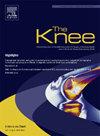全膝关节置换术提高膝关节骨关节炎患者行走时的能量转换效率。
IF 1.6
4区 医学
Q3 ORTHOPEDICS
引用次数: 0
摘要
背景:通过计算关节运动将机械能量从垂直运动转化为重心水平运动的比率,可以评价人体步态的能量转换效率。膝关节骨关节炎(OA)损害了这种能量转换效率。全膝关节置换术是膝关节OA的标准治疗方法。然而,其对能量转换效率的影响尚不清楚。在这项研究中,我们研究了膝关节OA患者手术前后步态中能量转换效率的变化。方法:12例单侧膝关节炎患者行全膝关节置换术。在手术前和手术后6个月,使用运动捕捉系统(VICON®)测量地面行走。通过质心的坐标变化计算势能和动能,得到能量转换效率。评估其他步态参数,如步态速度、身体中心垂直运动距离、步长、髋关节角度、前后肢角度等。结果:术后6个月手术侧能量转换效率由41.4±12.2%显著提高至57.5±9.2%。手术侧其他步态参数术后较术前有明显改善。术前手术侧与非手术侧步长、非手术侧尾肢角度与能量转换效率相关,术后6个月时,非手术侧步长、步态速度与能量转换效率相关。结论:膝关节OA患者术后能量转换效率明显提高。本文章由计算机程序翻译,如有差异,请以英文原文为准。
Total knee arthroplasty improves energy conversion efficiency during walking in patients with knee osteoarthritis
Background
Energy conversion efficiency of human gait can be evaluated by calculating the ratio of conversion of mechanical energy from vertical motion to horizontal motion of the center of gravity through the movement of the joints. Osteoarthritis (OA) of the knee joint impairs this energy conversion efficiency. Total knee arthroplasty is the standard treatment for knee OA. However, its effect on energy conversion efficiency is unclear. In this study, we investigated how energy conversion efficiency changed in the gait of patients with knee OA before and after surgery.
Methods
Twelve patients with unilateral knee OA who underwent total knee arthroplasty were included. Ground walking was measured using a motion capture system (VICON®) before and 6 months after surgery. We calculated potential and kinetic energy from the coordinate change of the center of mass to obtain energy conversion efficiency. Other gait parameters such as gait speed, vertical movement distance of the body center, step length, hip joint angle, and trailing and leading limb angles were assessed.
Results
Energy conversion efficiency on the operated side significantly improved from 41.4 ± 12.2% to 57.5 ± 9.2% 6 months after surgery. Other gait parameters on the operated side were significantly improved after surgery compared with before surgery. Step length on the operated and the non-operated sides and trailing limb angles on the non-operated side before surgery correlated to energy conversion efficiency, while at 6 months after surgery, gait speed and step length on the non-operated side correlated to energy conversion efficiency.
Conclusion
Energy conversion efficiency was strongly improved postoperatively in patients with knee OA.
求助全文
通过发布文献求助,成功后即可免费获取论文全文。
去求助
来源期刊

Knee
医学-外科
CiteScore
3.80
自引率
5.30%
发文量
171
审稿时长
6 months
期刊介绍:
The Knee is an international journal publishing studies on the clinical treatment and fundamental biomechanical characteristics of this joint. The aim of the journal is to provide a vehicle relevant to surgeons, biomedical engineers, imaging specialists, materials scientists, rehabilitation personnel and all those with an interest in the knee.
The topics covered include, but are not limited to:
• Anatomy, physiology, morphology and biochemistry;
• Biomechanical studies;
• Advances in the development of prosthetic, orthotic and augmentation devices;
• Imaging and diagnostic techniques;
• Pathology;
• Trauma;
• Surgery;
• Rehabilitation.
 求助内容:
求助内容: 应助结果提醒方式:
应助结果提醒方式:


